The Endocrine System: Functions of Hormones, Role of Blood, and Hormone Replacement Therapy
VerifiedAdded on 2023/05/28
|6
|1651
|381
AI Summary
The endocrine system secretes hormones that regulate metabolism, reproduction, growth, and other physiological activities. This essay discusses the major hormones, their functions, the role of blood in hormone distribution, and hormone replacement therapy. It also covers the glands and organs involved in the endocrine system.
Contribute Materials
Your contribution can guide someone’s learning journey. Share your
documents today.
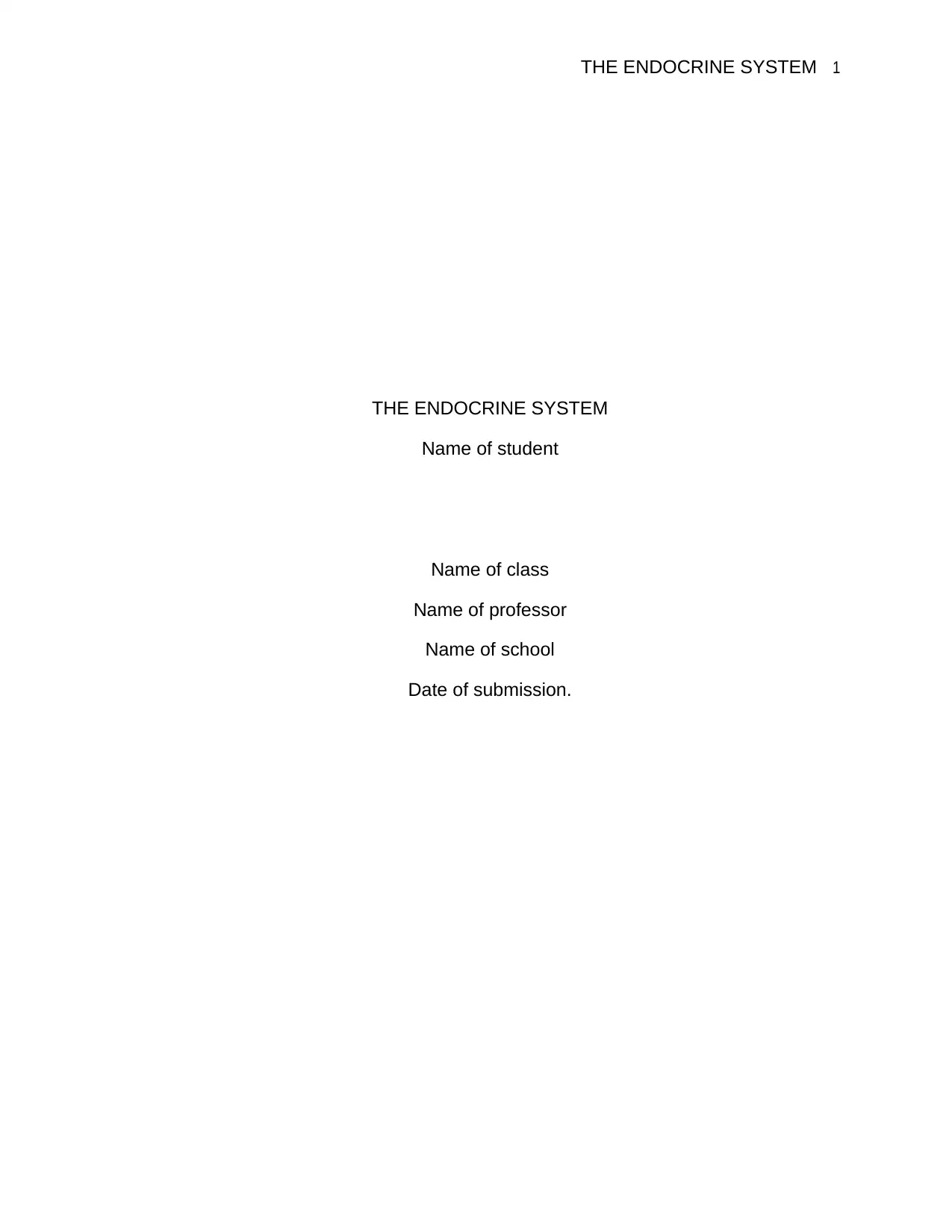
THE ENDOCRINE SYSTEM 1
THE ENDOCRINE SYSTEM
Name of student
Name of class
Name of professor
Name of school
Date of submission.
THE ENDOCRINE SYSTEM
Name of student
Name of class
Name of professor
Name of school
Date of submission.
Secure Best Marks with AI Grader
Need help grading? Try our AI Grader for instant feedback on your assignments.
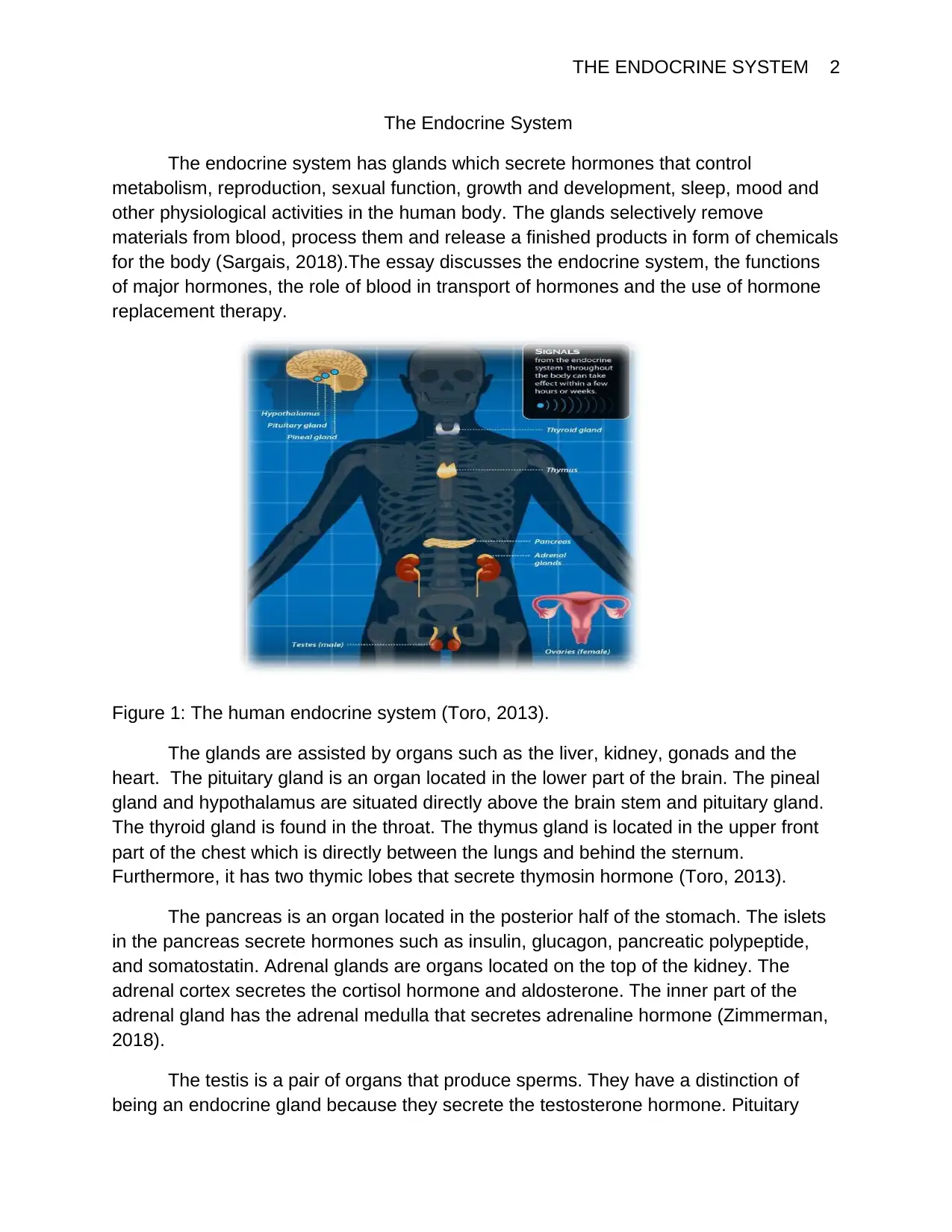
THE ENDOCRINE SYSTEM 2
The Endocrine System
The endocrine system has glands which secrete hormones that control
metabolism, reproduction, sexual function, growth and development, sleep, mood and
other physiological activities in the human body. The glands selectively remove
materials from blood, process them and release a finished products in form of chemicals
for the body (Sargais, 2018).The essay discusses the endocrine system, the functions
of major hormones, the role of blood in transport of hormones and the use of hormone
replacement therapy.
Figure 1: The human endocrine system (Toro, 2013).
The glands are assisted by organs such as the liver, kidney, gonads and the
heart. The pituitary gland is an organ located in the lower part of the brain. The pineal
gland and hypothalamus are situated directly above the brain stem and pituitary gland.
The thyroid gland is found in the throat. The thymus gland is located in the upper front
part of the chest which is directly between the lungs and behind the sternum.
Furthermore, it has two thymic lobes that secrete thymosin hormone (Toro, 2013).
The pancreas is an organ located in the posterior half of the stomach. The islets
in the pancreas secrete hormones such as insulin, glucagon, pancreatic polypeptide,
and somatostatin. Adrenal glands are organs located on the top of the kidney. The
adrenal cortex secretes the cortisol hormone and aldosterone. The inner part of the
adrenal gland has the adrenal medulla that secretes adrenaline hormone (Zimmerman,
2018).
The testis is a pair of organs that produce sperms. They have a distinction of
being an endocrine gland because they secrete the testosterone hormone. Pituitary
The Endocrine System
The endocrine system has glands which secrete hormones that control
metabolism, reproduction, sexual function, growth and development, sleep, mood and
other physiological activities in the human body. The glands selectively remove
materials from blood, process them and release a finished products in form of chemicals
for the body (Sargais, 2018).The essay discusses the endocrine system, the functions
of major hormones, the role of blood in transport of hormones and the use of hormone
replacement therapy.
Figure 1: The human endocrine system (Toro, 2013).
The glands are assisted by organs such as the liver, kidney, gonads and the
heart. The pituitary gland is an organ located in the lower part of the brain. The pineal
gland and hypothalamus are situated directly above the brain stem and pituitary gland.
The thyroid gland is found in the throat. The thymus gland is located in the upper front
part of the chest which is directly between the lungs and behind the sternum.
Furthermore, it has two thymic lobes that secrete thymosin hormone (Toro, 2013).
The pancreas is an organ located in the posterior half of the stomach. The islets
in the pancreas secrete hormones such as insulin, glucagon, pancreatic polypeptide,
and somatostatin. Adrenal glands are organs located on the top of the kidney. The
adrenal cortex secretes the cortisol hormone and aldosterone. The inner part of the
adrenal gland has the adrenal medulla that secretes adrenaline hormone (Zimmerman,
2018).
The testis is a pair of organs that produce sperms. They have a distinction of
being an endocrine gland because they secrete the testosterone hormone. Pituitary
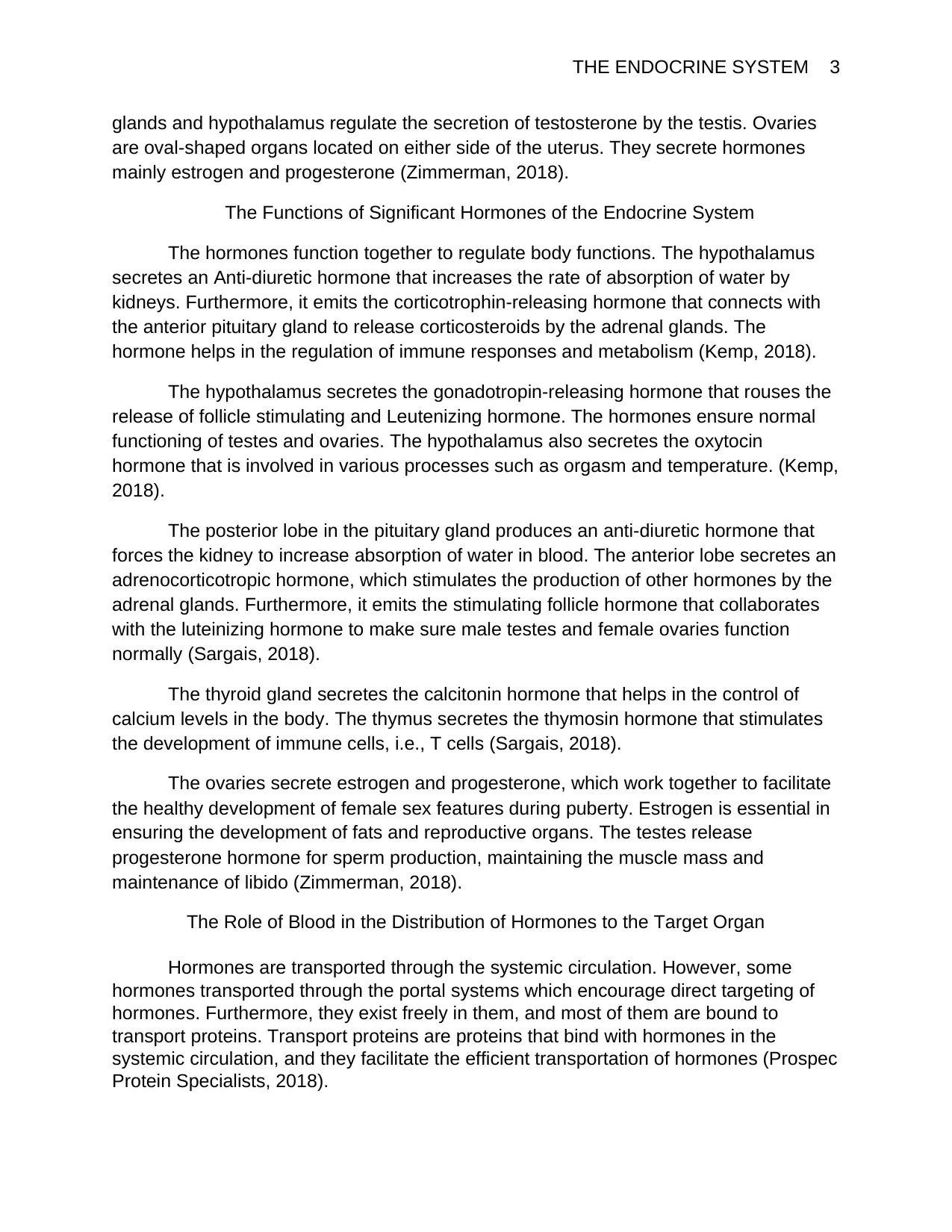
THE ENDOCRINE SYSTEM 3
glands and hypothalamus regulate the secretion of testosterone by the testis. Ovaries
are oval-shaped organs located on either side of the uterus. They secrete hormones
mainly estrogen and progesterone (Zimmerman, 2018).
The Functions of Significant Hormones of the Endocrine System
The hormones function together to regulate body functions. The hypothalamus
secretes an Anti-diuretic hormone that increases the rate of absorption of water by
kidneys. Furthermore, it emits the corticotrophin-releasing hormone that connects with
the anterior pituitary gland to release corticosteroids by the adrenal glands. The
hormone helps in the regulation of immune responses and metabolism (Kemp, 2018).
The hypothalamus secretes the gonadotropin-releasing hormone that rouses the
release of follicle stimulating and Leutenizing hormone. The hormones ensure normal
functioning of testes and ovaries. The hypothalamus also secretes the oxytocin
hormone that is involved in various processes such as orgasm and temperature. (Kemp,
2018).
The posterior lobe in the pituitary gland produces an anti-diuretic hormone that
forces the kidney to increase absorption of water in blood. The anterior lobe secretes an
adrenocorticotropic hormone, which stimulates the production of other hormones by the
adrenal glands. Furthermore, it emits the stimulating follicle hormone that collaborates
with the luteinizing hormone to make sure male testes and female ovaries function
normally (Sargais, 2018).
The thyroid gland secretes the calcitonin hormone that helps in the control of
calcium levels in the body. The thymus secretes the thymosin hormone that stimulates
the development of immune cells, i.e., T cells (Sargais, 2018).
The ovaries secrete estrogen and progesterone, which work together to facilitate
the healthy development of female sex features during puberty. Estrogen is essential in
ensuring the development of fats and reproductive organs. The testes release
progesterone hormone for sperm production, maintaining the muscle mass and
maintenance of libido (Zimmerman, 2018).
The Role of Blood in the Distribution of Hormones to the Target Organ
Hormones are transported through the systemic circulation. However, some
hormones transported through the portal systems which encourage direct targeting of
hormones. Furthermore, they exist freely in them, and most of them are bound to
transport proteins. Transport proteins are proteins that bind with hormones in the
systemic circulation, and they facilitate the efficient transportation of hormones (Prospec
Protein Specialists, 2018).
glands and hypothalamus regulate the secretion of testosterone by the testis. Ovaries
are oval-shaped organs located on either side of the uterus. They secrete hormones
mainly estrogen and progesterone (Zimmerman, 2018).
The Functions of Significant Hormones of the Endocrine System
The hormones function together to regulate body functions. The hypothalamus
secretes an Anti-diuretic hormone that increases the rate of absorption of water by
kidneys. Furthermore, it emits the corticotrophin-releasing hormone that connects with
the anterior pituitary gland to release corticosteroids by the adrenal glands. The
hormone helps in the regulation of immune responses and metabolism (Kemp, 2018).
The hypothalamus secretes the gonadotropin-releasing hormone that rouses the
release of follicle stimulating and Leutenizing hormone. The hormones ensure normal
functioning of testes and ovaries. The hypothalamus also secretes the oxytocin
hormone that is involved in various processes such as orgasm and temperature. (Kemp,
2018).
The posterior lobe in the pituitary gland produces an anti-diuretic hormone that
forces the kidney to increase absorption of water in blood. The anterior lobe secretes an
adrenocorticotropic hormone, which stimulates the production of other hormones by the
adrenal glands. Furthermore, it emits the stimulating follicle hormone that collaborates
with the luteinizing hormone to make sure male testes and female ovaries function
normally (Sargais, 2018).
The thyroid gland secretes the calcitonin hormone that helps in the control of
calcium levels in the body. The thymus secretes the thymosin hormone that stimulates
the development of immune cells, i.e., T cells (Sargais, 2018).
The ovaries secrete estrogen and progesterone, which work together to facilitate
the healthy development of female sex features during puberty. Estrogen is essential in
ensuring the development of fats and reproductive organs. The testes release
progesterone hormone for sperm production, maintaining the muscle mass and
maintenance of libido (Zimmerman, 2018).
The Role of Blood in the Distribution of Hormones to the Target Organ
Hormones are transported through the systemic circulation. However, some
hormones transported through the portal systems which encourage direct targeting of
hormones. Furthermore, they exist freely in them, and most of them are bound to
transport proteins. Transport proteins are proteins that bind with hormones in the
systemic circulation, and they facilitate the efficient transportation of hormones (Prospec
Protein Specialists, 2018).
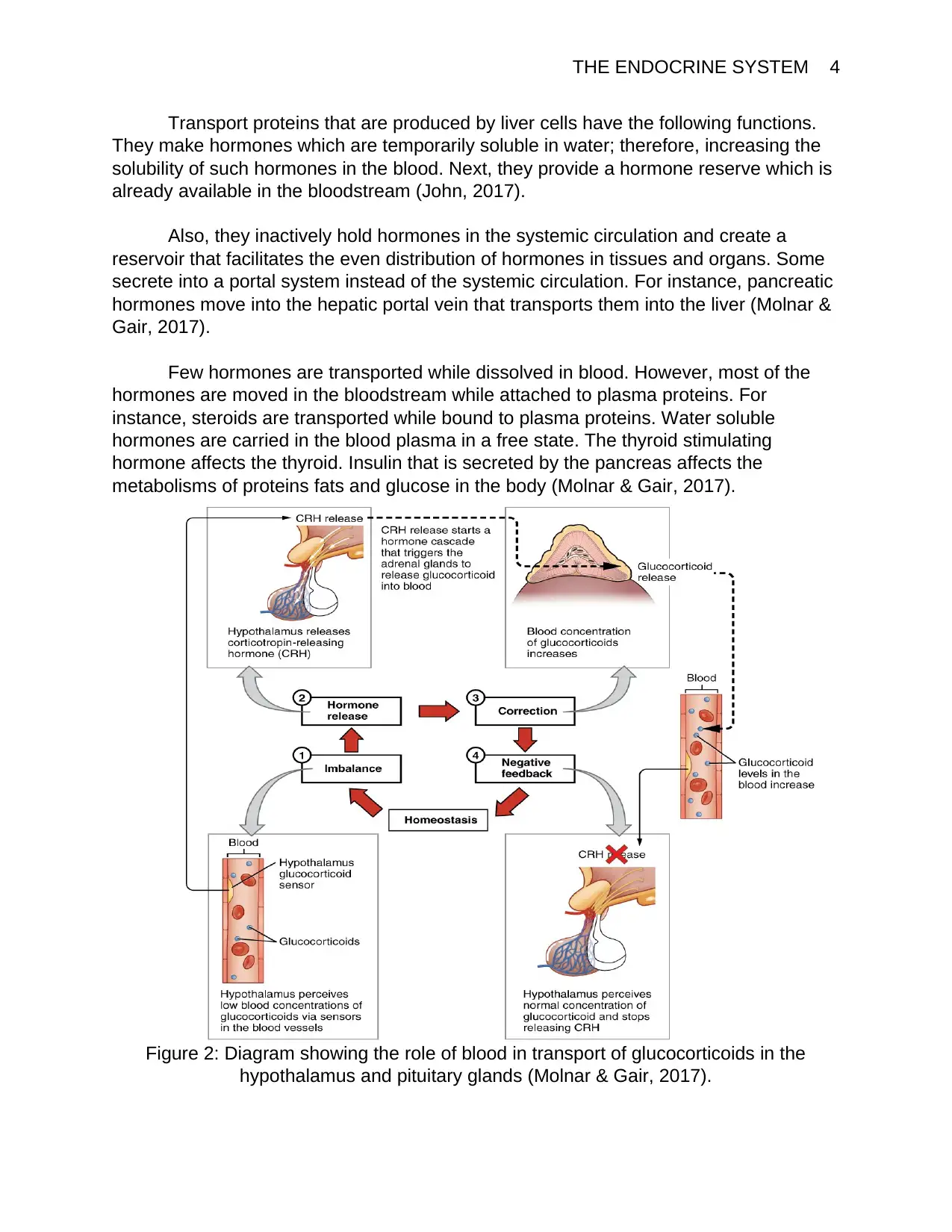
THE ENDOCRINE SYSTEM 4
Transport proteins that are produced by liver cells have the following functions.
They make hormones which are temporarily soluble in water; therefore, increasing the
solubility of such hormones in the blood. Next, they provide a hormone reserve which is
already available in the bloodstream (John, 2017).
Also, they inactively hold hormones in the systemic circulation and create a
reservoir that facilitates the even distribution of hormones in tissues and organs. Some
secrete into a portal system instead of the systemic circulation. For instance, pancreatic
hormones move into the hepatic portal vein that transports them into the liver (Molnar &
Gair, 2017).
Few hormones are transported while dissolved in blood. However, most of the
hormones are moved in the bloodstream while attached to plasma proteins. For
instance, steroids are transported while bound to plasma proteins. Water soluble
hormones are carried in the blood plasma in a free state. The thyroid stimulating
hormone affects the thyroid. Insulin that is secreted by the pancreas affects the
metabolisms of proteins fats and glucose in the body (Molnar & Gair, 2017).
Figure 2: Diagram showing the role of blood in transport of glucocorticoids in the
hypothalamus and pituitary glands (Molnar & Gair, 2017).
Transport proteins that are produced by liver cells have the following functions.
They make hormones which are temporarily soluble in water; therefore, increasing the
solubility of such hormones in the blood. Next, they provide a hormone reserve which is
already available in the bloodstream (John, 2017).
Also, they inactively hold hormones in the systemic circulation and create a
reservoir that facilitates the even distribution of hormones in tissues and organs. Some
secrete into a portal system instead of the systemic circulation. For instance, pancreatic
hormones move into the hepatic portal vein that transports them into the liver (Molnar &
Gair, 2017).
Few hormones are transported while dissolved in blood. However, most of the
hormones are moved in the bloodstream while attached to plasma proteins. For
instance, steroids are transported while bound to plasma proteins. Water soluble
hormones are carried in the blood plasma in a free state. The thyroid stimulating
hormone affects the thyroid. Insulin that is secreted by the pancreas affects the
metabolisms of proteins fats and glucose in the body (Molnar & Gair, 2017).
Figure 2: Diagram showing the role of blood in transport of glucocorticoids in the
hypothalamus and pituitary glands (Molnar & Gair, 2017).
Secure Best Marks with AI Grader
Need help grading? Try our AI Grader for instant feedback on your assignments.
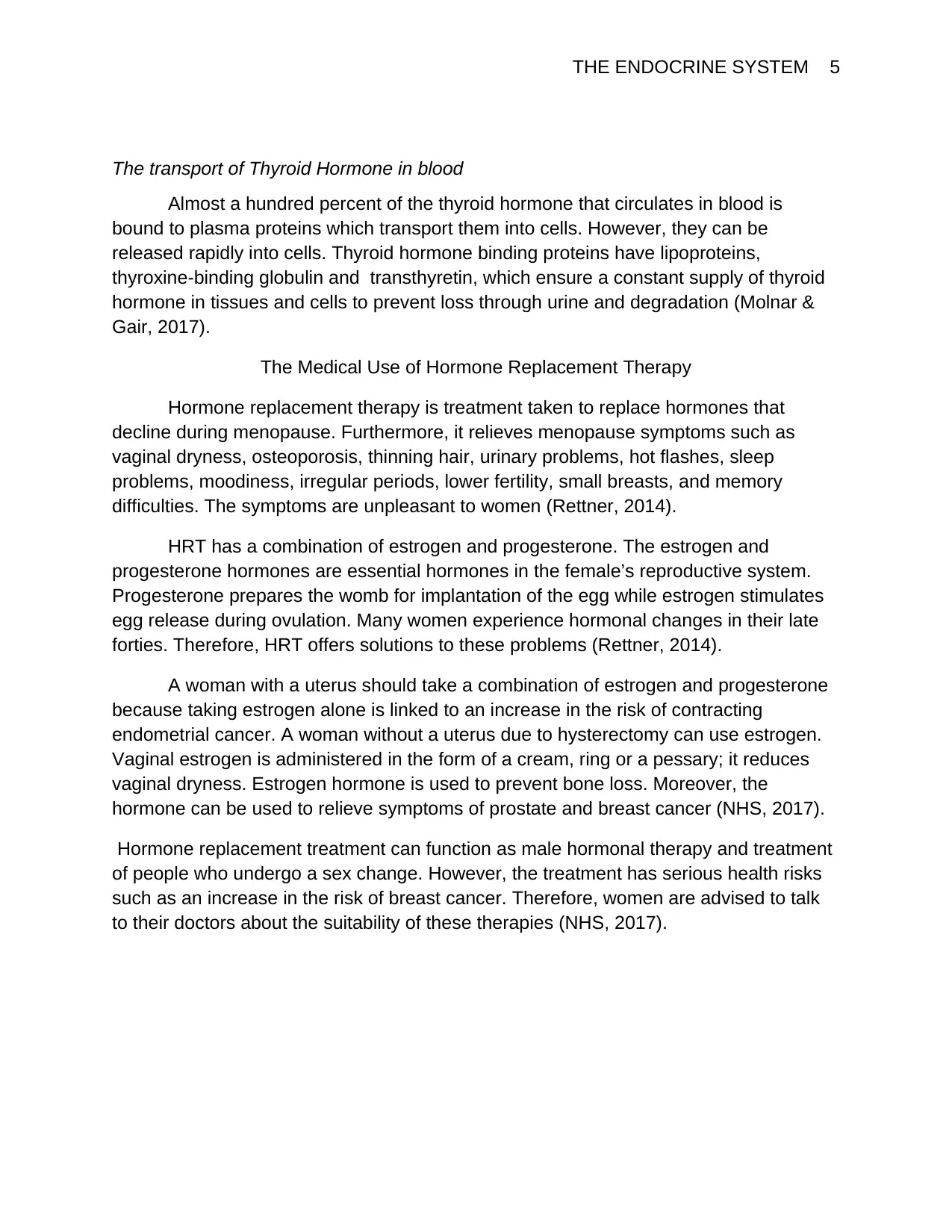
THE ENDOCRINE SYSTEM 5
The transport of Thyroid Hormone in blood
Almost a hundred percent of the thyroid hormone that circulates in blood is
bound to plasma proteins which transport them into cells. However, they can be
released rapidly into cells. Thyroid hormone binding proteins have lipoproteins,
thyroxine-binding globulin and transthyretin, which ensure a constant supply of thyroid
hormone in tissues and cells to prevent loss through urine and degradation (Molnar &
Gair, 2017).
The Medical Use of Hormone Replacement Therapy
Hormone replacement therapy is treatment taken to replace hormones that
decline during menopause. Furthermore, it relieves menopause symptoms such as
vaginal dryness, osteoporosis, thinning hair, urinary problems, hot flashes, sleep
problems, moodiness, irregular periods, lower fertility, small breasts, and memory
difficulties. The symptoms are unpleasant to women (Rettner, 2014).
HRT has a combination of estrogen and progesterone. The estrogen and
progesterone hormones are essential hormones in the female’s reproductive system.
Progesterone prepares the womb for implantation of the egg while estrogen stimulates
egg release during ovulation. Many women experience hormonal changes in their late
forties. Therefore, HRT offers solutions to these problems (Rettner, 2014).
A woman with a uterus should take a combination of estrogen and progesterone
because taking estrogen alone is linked to an increase in the risk of contracting
endometrial cancer. A woman without a uterus due to hysterectomy can use estrogen.
Vaginal estrogen is administered in the form of a cream, ring or a pessary; it reduces
vaginal dryness. Estrogen hormone is used to prevent bone loss. Moreover, the
hormone can be used to relieve symptoms of prostate and breast cancer (NHS, 2017).
Hormone replacement treatment can function as male hormonal therapy and treatment
of people who undergo a sex change. However, the treatment has serious health risks
such as an increase in the risk of breast cancer. Therefore, women are advised to talk
to their doctors about the suitability of these therapies (NHS, 2017).
The transport of Thyroid Hormone in blood
Almost a hundred percent of the thyroid hormone that circulates in blood is
bound to plasma proteins which transport them into cells. However, they can be
released rapidly into cells. Thyroid hormone binding proteins have lipoproteins,
thyroxine-binding globulin and transthyretin, which ensure a constant supply of thyroid
hormone in tissues and cells to prevent loss through urine and degradation (Molnar &
Gair, 2017).
The Medical Use of Hormone Replacement Therapy
Hormone replacement therapy is treatment taken to replace hormones that
decline during menopause. Furthermore, it relieves menopause symptoms such as
vaginal dryness, osteoporosis, thinning hair, urinary problems, hot flashes, sleep
problems, moodiness, irregular periods, lower fertility, small breasts, and memory
difficulties. The symptoms are unpleasant to women (Rettner, 2014).
HRT has a combination of estrogen and progesterone. The estrogen and
progesterone hormones are essential hormones in the female’s reproductive system.
Progesterone prepares the womb for implantation of the egg while estrogen stimulates
egg release during ovulation. Many women experience hormonal changes in their late
forties. Therefore, HRT offers solutions to these problems (Rettner, 2014).
A woman with a uterus should take a combination of estrogen and progesterone
because taking estrogen alone is linked to an increase in the risk of contracting
endometrial cancer. A woman without a uterus due to hysterectomy can use estrogen.
Vaginal estrogen is administered in the form of a cream, ring or a pessary; it reduces
vaginal dryness. Estrogen hormone is used to prevent bone loss. Moreover, the
hormone can be used to relieve symptoms of prostate and breast cancer (NHS, 2017).
Hormone replacement treatment can function as male hormonal therapy and treatment
of people who undergo a sex change. However, the treatment has serious health risks
such as an increase in the risk of breast cancer. Therefore, women are advised to talk
to their doctors about the suitability of these therapies (NHS, 2017).
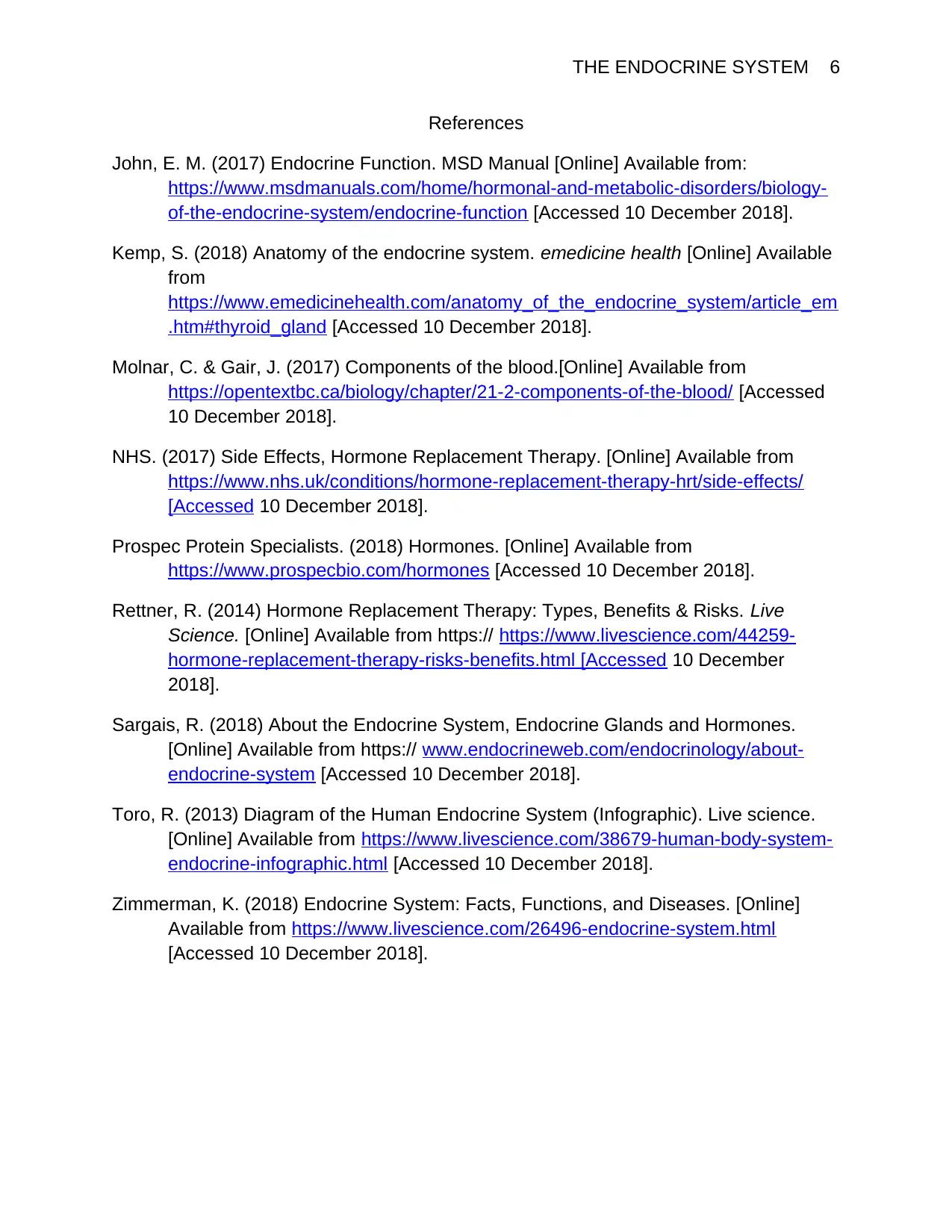
THE ENDOCRINE SYSTEM 6
References
John, E. M. (2017) Endocrine Function. MSD Manual [Online] Available from:
https://www.msdmanuals.com/home/hormonal-and-metabolic-disorders/biology-
of-the-endocrine-system/endocrine-function [Accessed 10 December 2018].
Kemp, S. (2018) Anatomy of the endocrine system. emedicine health [Online] Available
from
https://www.emedicinehealth.com/anatomy_of_the_endocrine_system/article_em
.htm#thyroid_gland [Accessed 10 December 2018].
Molnar, C. & Gair, J. (2017) Components of the blood.[Online] Available from
https://opentextbc.ca/biology/chapter/21-2-components-of-the-blood/ [Accessed
10 December 2018].
NHS. (2017) Side Effects, Hormone Replacement Therapy. [Online] Available from
https://www.nhs.uk/conditions/hormone-replacement-therapy-hrt/side-effects/
[Accessed 10 December 2018].
Prospec Protein Specialists. (2018) Hormones. [Online] Available from
https://www.prospecbio.com/hormones [Accessed 10 December 2018].
Rettner, R. (2014) Hormone Replacement Therapy: Types, Benefits & Risks. Live
Science. [Online] Available from https:// https://www.livescience.com/44259-
hormone-replacement-therapy-risks-benefits.html [Accessed 10 December
2018].
Sargais, R. (2018) About the Endocrine System, Endocrine Glands and Hormones.
[Online] Available from https:// www.endocrineweb.com/endocrinology/about-
endocrine-system [Accessed 10 December 2018].
Toro, R. (2013) Diagram of the Human Endocrine System (Infographic). Live science.
[Online] Available from https://www.livescience.com/38679-human-body-system-
endocrine-infographic.html [Accessed 10 December 2018].
Zimmerman, K. (2018) Endocrine System: Facts, Functions, and Diseases. [Online]
Available from https://www.livescience.com/26496-endocrine-system.html
[Accessed 10 December 2018].
References
John, E. M. (2017) Endocrine Function. MSD Manual [Online] Available from:
https://www.msdmanuals.com/home/hormonal-and-metabolic-disorders/biology-
of-the-endocrine-system/endocrine-function [Accessed 10 December 2018].
Kemp, S. (2018) Anatomy of the endocrine system. emedicine health [Online] Available
from
https://www.emedicinehealth.com/anatomy_of_the_endocrine_system/article_em
.htm#thyroid_gland [Accessed 10 December 2018].
Molnar, C. & Gair, J. (2017) Components of the blood.[Online] Available from
https://opentextbc.ca/biology/chapter/21-2-components-of-the-blood/ [Accessed
10 December 2018].
NHS. (2017) Side Effects, Hormone Replacement Therapy. [Online] Available from
https://www.nhs.uk/conditions/hormone-replacement-therapy-hrt/side-effects/
[Accessed 10 December 2018].
Prospec Protein Specialists. (2018) Hormones. [Online] Available from
https://www.prospecbio.com/hormones [Accessed 10 December 2018].
Rettner, R. (2014) Hormone Replacement Therapy: Types, Benefits & Risks. Live
Science. [Online] Available from https:// https://www.livescience.com/44259-
hormone-replacement-therapy-risks-benefits.html [Accessed 10 December
2018].
Sargais, R. (2018) About the Endocrine System, Endocrine Glands and Hormones.
[Online] Available from https:// www.endocrineweb.com/endocrinology/about-
endocrine-system [Accessed 10 December 2018].
Toro, R. (2013) Diagram of the Human Endocrine System (Infographic). Live science.
[Online] Available from https://www.livescience.com/38679-human-body-system-
endocrine-infographic.html [Accessed 10 December 2018].
Zimmerman, K. (2018) Endocrine System: Facts, Functions, and Diseases. [Online]
Available from https://www.livescience.com/26496-endocrine-system.html
[Accessed 10 December 2018].
1 out of 6
Related Documents
Your All-in-One AI-Powered Toolkit for Academic Success.
+13062052269
info@desklib.com
Available 24*7 on WhatsApp / Email
![[object Object]](/_next/static/media/star-bottom.7253800d.svg)
Unlock your academic potential
© 2024 | Zucol Services PVT LTD | All rights reserved.





